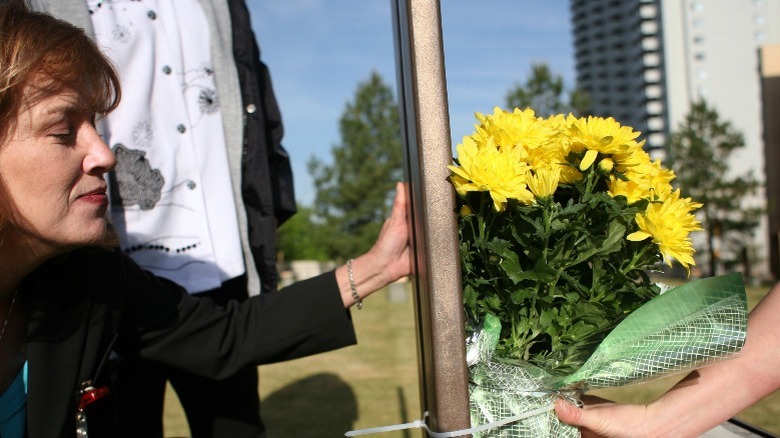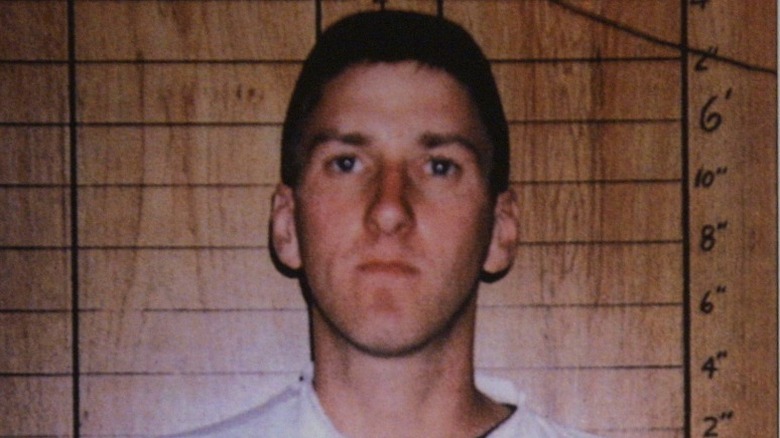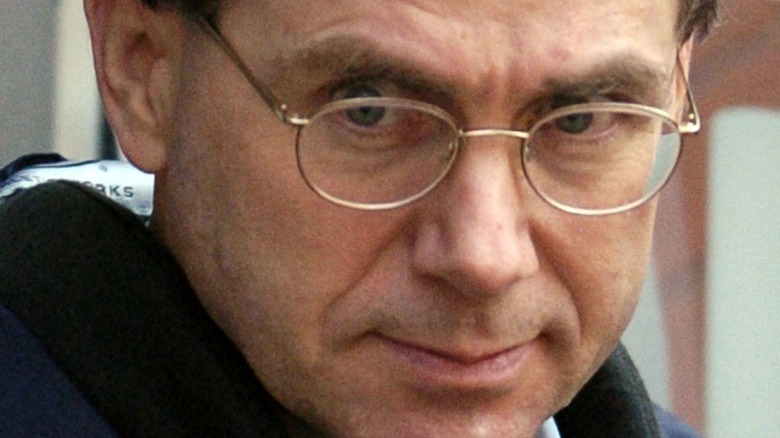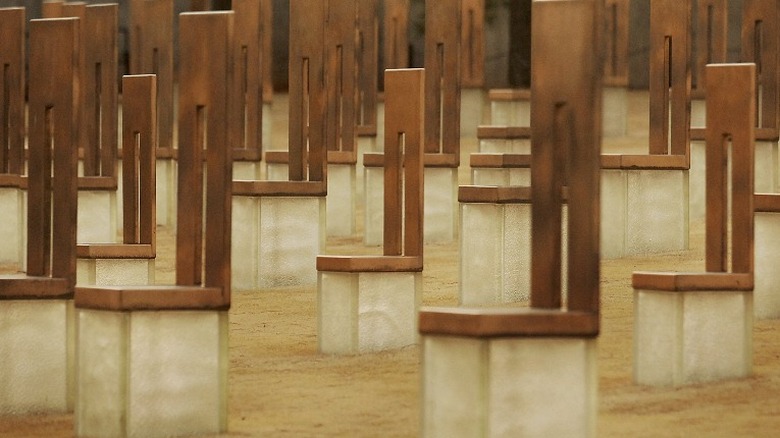What Were The Sentences For Timothy McVeigh's OKC Bombing Accomplices?
April 19, 1995, marked a dark day in United States history. That morning at approximately 9:02 a.m., an explosion shook the Alfred P. Murrah Federal Building in Oklahoma City. In the aftermath, it was discovered that at least 168 victims died in a terrorist attack on American soil (via Britannica). Further investigations revealed that this attack wasn't carried out by foreign assailants — the perpetrators were United States citizens, some of whom had served their country in the military.
The terror attack in Oklahoma City was the deadliest terrorist attack in the history of the United States until September 11, 2001 (per History News Network). As with large-scale, coordinated attacks on any system, there were multiple perpetrators involved. While the name Timothy McVeigh still rings in the heads of most Americans who were alive at the time, many might not be aware of the identities of the others that were involved and arguably just as culpable.
It also might surprise some readers to know that not all of those found guilty of this act of terrorism are still behind bars, and at least one person was able to avoid prison time altogether.
The extent of the damage was vast
Timothy McVeigh detonated the bomb just outside the federal building, constructing it from diesel fuel, fertilizer, and other components. The National Institute of Standards and Technology states that the blast was so powerful that it managed to destroy half of the building. In part of the building, the upper floors collapsed onto the ones below, helping to make it unsuitable for reconstruction. In the end, it was decided to demolish the structure. For safety reasons, the building was taken down as soon as a green light was given by investigators in May 1995. The Oklahoma City National Memorial Museum was constructed on the former site of the bombing, opening on April 19, 2000.
History reports that out of the 168 deaths from the blast, 19 were children. In addition to the federal building being a total loss, extensive damage was also done to surrounding buildings. All told, there were more than 300 buildings damaged or destroyed by the bombing.
McVeigh was sentenced to death
According to History, Timothy McVeigh was put on trial in 1997 in federal court. After a lengthy trial, he was found guilty on 15 charges of murder and conspiracy. Following his conviction in June, McVeigh was given the death sentence by the jury in August of that year. The jury's decision to sentence him to death was unanimous.
History goes on to report that in December 2000, McVeigh made a formal request to his federal judge that would effectively set aside all of his appeals. The Associated Press reported that McVeigh had already lost two appeals, and his filing with the court not only sought to do away with any remaining appeals but also requested that his death sentence be carried out within 120 days of the filing. The request was granted and an execution date set. McVeigh was put to death by lethal injection at the federal prison in Terre Haute, Indiana, on June 11, 2001 (per PBS).
Terry Nichols is serving life in prison
Timothy McVeigh found plenty of help constructing his deadly bomb in friend Terry Nichols. Nichols helped McVeigh secure most of the needed materials for the bomb and even drove him to Oklahoma City. Though he was back at his home in Herrington, Kansas during the bombing, officials were able to tie him to McVeigh as an accomplice.
Britannica reports that Nichols was officially charged on May 10, 1995, and formally indicted later that summer. In his 1997 trial, Nichols was found guilty of one count of conspiracy against the government and eight separate charges of involuntary manslaughter. He was given life without the possibility of parole.
State charges were also brought against Nichols by officials in Oklahoma. Found guilty on 161 first-degree murder charges, Nichols faced the death penalty but was able to escape it in his federal trial as the jury was unable to give unanimous consent for that punishment. And as Oklahoma law mandates that any death penalty verdict be unanimous, the state was forced to settle on 161 life sentences, served consecutively without any possibility of parole.
Nichols is currently incarcerated at the ADX Supermax federal prison in Florence, Colorado. He is serving his time alongside other notorious terrorists, including Unabomber Ted Kaczynski and Olympic Park Bomber Eric Rudolph (via CBS News).
Michael Fortier recieved a reduced sentence
Michael Fortier first met Timothy McVeigh when the two were enlisted in the army together. McVeigh brought Fortier in on his bombing plot nearly a year prior to the act, demonstrating to both Fortier and his wife the entire bomb plot while at the couple's kitchen table. The Southern Poverty Law Center reports that Fortier also gave aid to McVeigh by selling stolen guns to help finance the job. He even drove with McVeigh to Oklahoma City to help him case out the bombing site.
Charged with failing to alert authorities about the bombing plot, lying to investigators, and selling stolen weapons, Fortier was able to cut a deal with the prosecutors. In exchange for a reduced sentence, he would plead guilty and testify against McVeigh. Fortier served 11 years of his sentence before being released in 2006. He — along with his wife and two children — was also given a new identity and placed in the witness protection program. The government also provided them free housing as part of the deal.
Others who were arrested in relation to the bombing
Michael Fortier's wife, Lori, was detained and was threatened with charges of acting in the capacity of an accomplice for the attack. The New York Times states that Lori Fortier knew in early 1994 that McVeigh planned on detonating a bomb inside a federal building and even knew which one. She even went as far as helping McVeigh laminate a fake ID so that he was able to rent the Ryder truck that carried the bomb's payload to Oklahoma City.
As earlier discussed, Fortier testified against McVeigh in exchange for a lighter sentence. But one other condition was immunity for his wife. Prosecutors accepted both terms so long as Lori would take the stand against McVeigh during his trial. As one of the principal witnesses against him, both Fortiers helped the federal government secure a conviction for McVeigh.
Terry Nichols' brother, James, was also arrested in connection to the conspiracy. James Nichols owned the farm where McVeigh lived for a time and was even listed as the terrorist's next of kin when he was arrested. Though authorities discovered bomb-making materials on James' farm, they did not link him to the attack in Oklahoma City. He was arrested and detained for questioning for a month before being released and placed under strong surveillance. James Nichols was never charged with any crime related to the bombing. He passed away in 2017 (per The New York Times).





